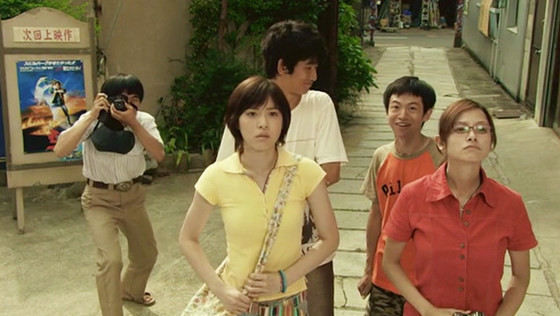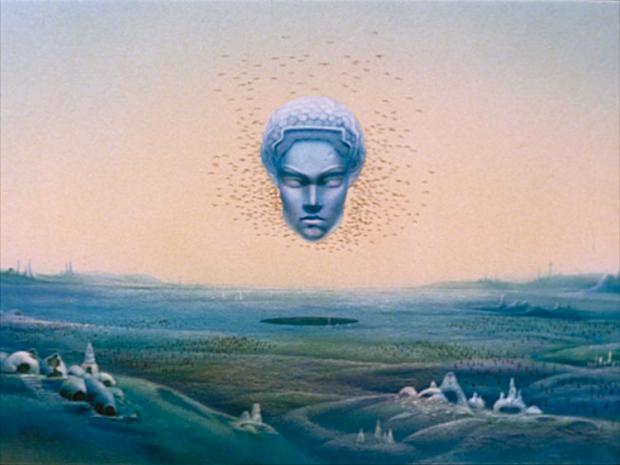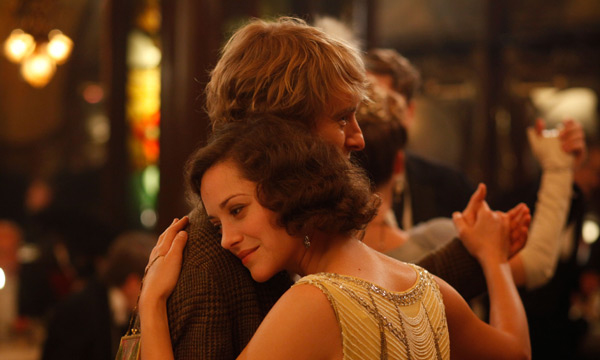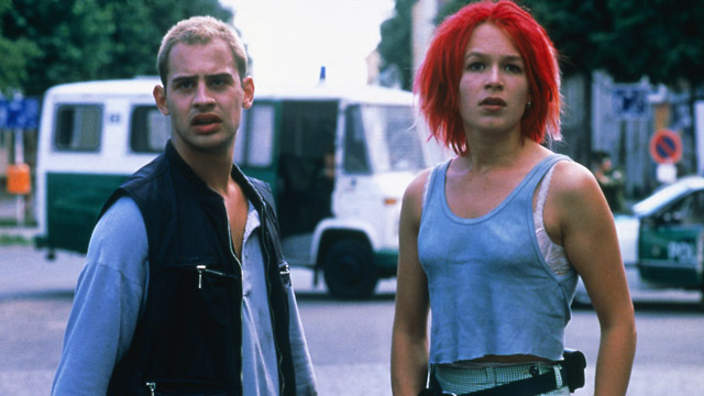5. Summer Time Machine Blues (2005)

Method of Time Travel: A rip-off of 1960’s THE TIME MACHINE.
This film is akin to taking off on a roller coaster and immediately being smacked on the head with an iron bar labelled ‘various time travel theories’. It hurts a little, but your constant snickering wins out.
As the coaster goes up and down, round and round, these various theories visibly dance above your head but never congeal. After having your stomach drop to the ground then suddenly thrust back up into your throat, the theories fall away until the destiny-validating Novikov self-consistency principle remains. You finally get a good, clear look at it as the coaster pulls into the station, and you step out, emitting a rhythmic ‘haha-wow-haha-wow’.
SUMMER TIME MACHINE BLUES would not be a favorite of the scientific community due to the theory it promotes, but it’s doubtful that anyone could resist its manic energy. An agreeably nutty story about five Japanese college kids who go back in time to prevent Coke from being spilled on their air conditioning remote, this film has references galore and a sharpness in the storytelling that make it accessible to just about everyone.
Director Katsuyuki Motohiro does a bang up job disguising the stage play origins of Makoto Ueda’s script. Though there is some familiarity to the goings-on, the atypicality here comes from how well it all works. Goofy without being annoying, sweet without being cloying, heady without being pretentious. Solid stuff. Check it out if you are in the need of some haha-wows.
4. Gandahar (1988)

Method of Time Travel: A glowing, pink ‘time door’.
Utopia has a bizarre yet attractive appearance in Rene Laloux’s GANDAHAR. Pastel vistas, blue-skinned humanoid women that happily breast feed overgrown mutant shrimp, fish that race to sacrifice themselves as sustenance for other life forms, coal black shock troopers that turn unsuspecting Gandaharians to stone – you know, paradise.
Of course, that last bit would only be a utopian ideal if you were Metamorphis, an intelligent being that appears to be a combination of a veiny, pink posterior and a human brain, blown up to about 250 times its normal size.
Having been abandoned in the ocean as a failed genetic experiment by the ruling class of Gandahar, its prolonged isolation caused this unfortunate creature to go mad and consume all organic material to both prolong its life and extend its capabilities far beyond the original intention. Once the entire planet died, Metamorphis began sending robotic troopers back in time to periods where planet Gandahar still lived, creating an Ouroboros-like scenario that spells certain doom for the existence of Gandahar in any time period.
The aforementioned ruling class, now feeling great shame over the price paid for the creation of said utopian harmony, proceed with a plan of using a Joseph Campbell-esque ‘chosen one’ – a nondescript, blue-hued, featherweight Conan named Sylvain – to find Metamorphis and put an end to the constant disruption of paradise. Along the way, we get many 80’s style, Star Wars-influenced science fantasy tropes, a somewhat nonsensical plot that is explained rather than shown, and at least a baker’s dozen of sequences that dilate the pupils without the need for narcotics.
Time is a recurring theme in all of Rene Laloux’s impleasingly small feature output, but in GANDAHAR, it becomes a plot mechanic used to tell a story of how the road to hell is paved with utopian intentions. The scale is big, the ambition is high, but due to a wobbly script, the storytelling doesn’t entirely succeed.
Despite this, it contains enough compelling ideas to remain intriguing, and Philippe Cazaumayou (Caza)’s visual design is a Metal Hurlant-cum-Saturday Morning chest of wonders. Whatever you do, avoid LIGHT YEARS, the American version that was dispassionately rescripted by Isaac Asimov and had a bullish Harvey Weinstein assume full directing credit.
3. Midnight In Paris (2011)

Method of Time Travel: A horse-drawn carriage that magically appears as the clock strikes midnight.
Aided immensely by the warm, enveloping lensing of Darius Khondji, Woody Allen presents MIDNIGHT IN PARIS as a statement of how too much literal-minded, ‘follow the leader’ thinking robs life of its magic. In doing so, he created his most entertaining film in years, and his magical realist approach to the time travel element perfectly suits his themes. Don’t sit there waiting for a detailed explanation of how a random carriage can just whisk someone away to the Paris of the 1920s – you won’t get it. Nor should you. Just go with it.
This time around, Allen casts Owen Wilson as his proxy. At first, Wilson may seem like an unlikely choice due to his status as an expert purveyor of modern smarm-charm, but his performance here is aces. This is one instance where the lead actor isn’t just Woody Allen with a younger, more attractive appearance.
Sure, he has his anxieties, but it could be that Allen has so clearly defined his character’s wants and desires that it allows Wilson to truly dig in and rise above predictability. His Gil is lost in life, his soul just a hair above being crushed from selling out his writing talent for immense paychecks to support the high-status lifestyle of his grating fiancee (a note-perfect Rachel McAdams).
After accompanying his future in-laws on a business trip to Paris, the otherworldly ambiance of the city gradually seduces him into a magical time trip. The trip reveals to him the possibility of a lifestyle more suited to his nature, and also that living in the past is not conducive to a meaningful and productive present. Embrace where and when you are, warts and all. Just don’t be afraid to make the necessary changes so that the present can be the best it can possibly be.
In addition to being a rollicking good time, MIDNIGHT IN PARIS has a decent amount to say about how art can connect you with times long past, people long gone, and how that in itself is a form of time travel. Indeed, Mr. Allen may be saying that time travel is already possible – it just requires you to free your mind and listen to your soul. As such, it seems to reinforce the idea prevalent in RUN LOLA RUN and many other stories that handle this subject – time, in a literal sense, is a prison.
2. Run Lola Run [Lola Rennt] (1998)

Method of Time Travel: Red-colored power of human will.
The opening shot of Tom Tykwer’s RUN LOLA RUN says it all: in the world of this film, time is the enemy. The monster head pendulum of a ticking clock swallows us, forcing us to play an unnecessary game. Too many facets of life perpetuated by an overt clinging to numbers and the concept of time seem to bring out the worst in us, and it is by the sheer force of human will that we can break these self-imposed chains and truly embrace mankind’s full potential.
In this film, Tykwer sets up the simple premise that a girl named Lola (Franke Potente) has twenty minutes to collect 100,000 Deutsche Marks and run all the way across town to save the life of her boyfriend Manni (Moritz Bleibtreu). The first time she tries, she fails. Before death, she recalls a previous conversation with Manni that questioned the integrity of their bond.
Now realizing that she is not ready to leave him in death, she wills herself back alive to try the scenario over again, remembering the mistakes she made the first time. The scenario repeats two more times before both Lola and Manni learn to be much more assertive, to ignore the ticking clock prison more and more, and the result is that the seemingly random machinations of the universe play more in their favor in some of the most unexpected ways.
Tykwer’s approach and point of view within the film is provocative. The idea of time being a prison that humans impose upon themselves is very interesting, and the notion that time may be something that we have to eventually forego in order for human perception and ability to evolve makes sense.
The human mind is extremely limited in its perception of reality, and time itself is a human construct, meant to be bent, broken, reconstructed, or dismissed as we see fit. These themes, combined with Tykwer’s extremely visceral and creative direction, make RUN LOLA RUN a quite entertaining ride that can provoke thought about the human race’s relationship with time – even if the film plays more in metaphor than actuality.
1. Je t’aime, je t’aime [I Love You, I Love You] (1968)

Method of Time Travel: A vaguely brain-shaped room with electrodes jammed into the top-center.
Memory has been the defining theme throughout the career of French filmmaker Alain Resnais. Armed with a 240-page script that was pared down from nearly a thousand pages of co-author Joseph Sternberg’s stream of consciousness writing, Resnais sought to illustrate how emotion-based clinging to memories past can render us effectively dead inside.
To do this, he tells the story of Claude Ridder (Claude Rich, who effortlessly embodies the ‘insert your own face here’ everyman quality), a writer recovering from a failed suicide attempt. Having nothing left to live for, he volunteers to be a guinea pig in a private research firm’s ongoing time-travel experiment.
The firm has (theoretically) sent a mouse back in time for exactly one minute, but since the mouse cannot communicate, they seek to move onto human trials to make sure that the experiment is a success. Should it fail, no matter – Claude didn’t want to live, anyway. The idea is that Claude will be sent back in time exactly one year from the present, and will stay for exactly one minute. He comes back, tells the researchers that it worked, and that is that. If only it were that easy…
With a malfunctioning experiment that causes Claude to ping-pong through random memories of the relationship with his now-deceased wife Catrine (Olga Georges-Picot), Resnais creates a believable approximation of how the human mind handles memories – especially those charged with deep emotion.
Anyone who has been in relationships similar to Claude and Catrine’s could surely understand; a broken heart can cause the mind to go haywire, fiercely trying to figure out how it all could have gone so wrong, forcing you play defense from memories that illustrate how so much of the fault was yours.
Here, the danger is greatly exacerbated by how the time machine allows Claude to dwell inside of these memories, making them play out again and again in three-dimensional reality, thereby never allowing his heart and soul to truly heal. As a result, though his fate is left ambiguous, one can successfully venture a guess as to how the final results of the experiment will affect the possibly slim remainder of Claude’s life.
Complete with an all-choral musical score by the ‘never one to write music for a frolic’ Krzysztof Penderecki, Resnais fashions JE T’AIME JE T’AIME as a sort of requiem for Claude. Since both his mind and heart seem hopelessly trapped within the memory of what he could and couldn’t do for his late wife, his notion of physical suicide seems almost like overkill. The film, as a whole, becomes a chilling reminder of how important it is to move forward, even after the most heartbreaking extremes.
Author Bio: Joshua Davis is yet another writer and filmmaker living in Los Angeles. He is slowly but surely replacing the ‘yet another’ with ‘a successful’. Writing ‘a sucnother writer and filmmaker…’ would be an accurate display of his progress.